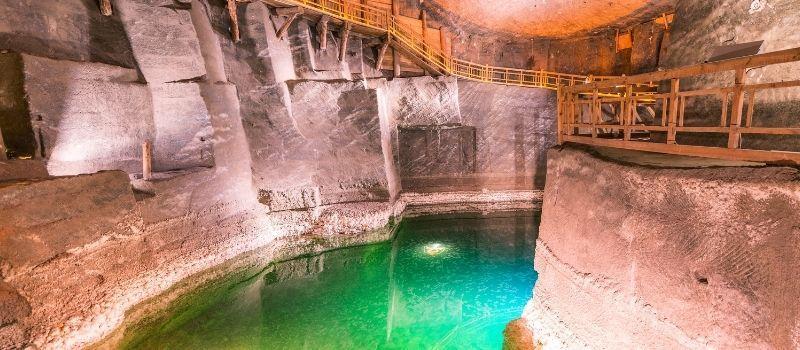Most people think salt is simply to add flavour to meals and to be used as a food preservative. However, only 6% of all salt manufactured goes into food. We use salt in over 14,000 different ways from making products such as paper, plastic, glass, polyester and rubber to household soap, bleach, dyes and detergents. Another common use of salt is to treat icy roads and paths in winter, this is because salt has a lower freezing point than water. Everyone uses salt, whether its directly or indirectly.
Salt can be obtained from either the sea or from underground salt deposits. There are many different types and grades of salt and several different methods to produce it. White salt is produced by evaporating “solution-mined” brine in pressure vessels. The brown rock salt we use for gritting roads come from mining ancient deposits.
What is a salt mine and how do they work?
Salt mines are used to extract natural salt deposits. When the salt is mined it will be in the form of halite and will need to be broken down further to create the salt that we use every day. This includes things such as gritting, weedkillers, tablets as animal feed, skin products, cleaning.
There are two ways you can extract salt when mining, deep shaft mining or solution mining.
Deep Shaft Mining
Using a method called the ‘room-and-pillar' method, ‘rooms’ are created through cutting, blasting and drilling between shafts which leaves behind supporting ‘pillars.’ Once this is all operational, machinery can begin to extract and crush salt.
Solution Mining
Construction wells are formed over salt domes and beds collect salt deposits, they are then dissolved by injecting them with water. The salt deposits are collected when tectonic pressure forces the deposits out of the Earth. The salt solution is transported to a plant, where it is evaporated, and the remaining salt is dried and refined.
History of salt mines
The earliest known salt mining can be dated back to 6000 BC, in the Chinese province of Shanxi at Lake Yuncheng. Although many argue that salt mining dates back further than this date.
In 1843, a Polish doctor stated that salt mines had positive impacts on the human respiratory system. The doctor’s findings were based on the reduced inflammation and mucus found on the respiratory system of mine workers compared to the general population.
Salt mines were deemed at one stage in history as the most dangerous form of mining due to:
- Quick dehydration caused by consistent contact with salt
- Excessive sodium intake
Today, salt mining is deemed the safest form of mining.
Salt mines around the world
Winsford, UK
The largest and oldest working salt mine in the UK. Originates back to 1844 when local prospectors were searching for coal.
Despite many ups and downs for the mine over during the 19th and 20th century, Winsford mine remains the largest supplier of natural rock salt in the UK.
Ontario, Canada
The world’s largest underground salt mine located 1,800 feet under Lake Huron. To put this into perspective, the mine is deep as the CN Towner in Toronto is tall.
The Ontario salt mine provides salt for the majority of North America, helping keep citizens safe in snowy/icy conditions and helping business in the manufacturing of various plastics, disinfectants and detergents.
Unirea, Romania
The largest salt mine in Europe is in a town called Slanic in Romania, this town is famous for the “Unirea Salt Mine”. This salt mine is a health spa formed of 14 rooms which are a sanatorium for the treatment of respiratory diseases. This mine welcomes both patients and tourists.
Cathedral of Salt, Columbia
The Cathedral of Slat in Columbia is a tourist hotspot, attracting 3,000 plus visitors on most Sundays. Approximately 10,000 people can fit into the cathedral.
This version of the cathedral has been open since 1995, when locals built it 200 feet below the original that was closed in 1990 due to safety concerns.
Khewra Salt Mines, Pakistan
Said to be discovered by Alexander the Great in 326 BC, well his horse did most the work. As the horse rested it began to lick stone. A soldier did the same and discovered the salty flavour.
Today this is the second largest salt mine in the world, turning over 325,000 tonnes of salt a year.
If you’d like to find out more about the salt we have available, please contact our sales team on 01777 858009 or email sales@kingfisherdirect.co.uk.






